If you’re unsure whether to bring your kids to Body Worlds: Pulse at Discovery Times Square, look at the pictures below. If you think they can handle these pictures, then go (more details below). This is the second “body” exhibition I’ve taken my kids to. The last one was probably in 2007 or 2008 when my kids were much younger. They still remember it, especially seeing the black lung from smoking. That had an impact on them.
If you’re not familiar with the Body Worlds world, there is a lot of history behind it. Briefly, these people donated their bodies for plastination (controversial), the technique used here to preserve the body in various shapes. I’ll go into the process in more depth later. There’s a lot of controversy surrounding the Bodies exhibitions, ranging from whether people indeed DID donate their bodies, to the ethics of displaying bodies this way, to religious complaints, to the sale of plastinated organs and bodies. You can read more here – it’s quite interesting.
You’ll start out with a video which I found stressful. It talked about stress and the pace of life these days. The video was captivating (and frenetic) in that it was made with drawings of people and things that were done during the video (but sped up). For the first time in history there are more people that are over age 60, than under age 5. The show uses the plastinated bodies and organs to talk about health, how the body shows its health, how to stay healthy, focusing on areas like happiness, blood pressure, exercise, stress and food. And it shows how the body works.
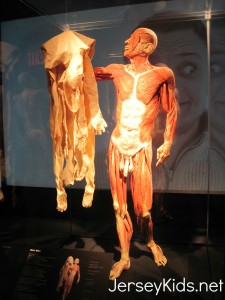
The first display was a bit shocking. The skin is the largest and heaviest organ. The skin still has some hair on it.
The exhibition went into different body parts, like the knee, which needs 13 muscles and ligaments for stability. They showed the difference between normal and arthritic knee joints and hip joints. While not shown here, they displayed Tai Chi Man, which had separators pulling aside muscle to show all the repairs made to his broken bones during his life. It talked about how in old age, the spine shrinks up to 2 3/4″ due to disease and bone density reduction, stressing why it’s important to stay in shape.
————————————————
[ad name=”Google Adsense”]
————————————————
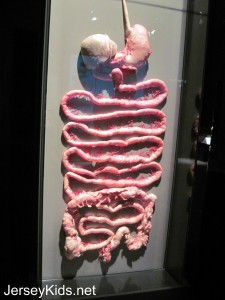
The exhibition showed many individually preserved organs, in a way that was easier to understand because they were in front of you. You can see the intestines above, showing how long they are and the difference between the large and small intestines.
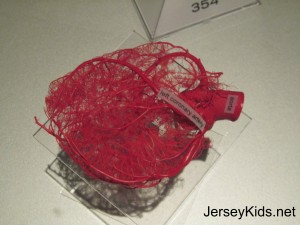
In addition to showing individual organs, they showed them in interesting ways – like with the heart above showing just the circulatory system. They also had a whole heart, showing the size of it when it’s normal and when it’s diseased. The heart only weighs about 10 ounces, but pumps 3 ounces of blood per beat. You can try out their blood pressure monitor, one of only interactive elements of the exhibition.
They injected a red dye for effect. Below is the circulatory system of an entire lamb.

The exhibition shows different ways to view a body. Like below, where they showed the central and peripheral nervous system. The main branch signals travel up to 250 mph.
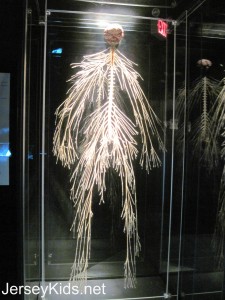
Not displayed, there’s a section on the brain as well, and a short video talking about how in this digital age, the brains of our kids are being rewired so they aren’t able to learn in classes effectively, because they have no control over the situation (like they do in video games).
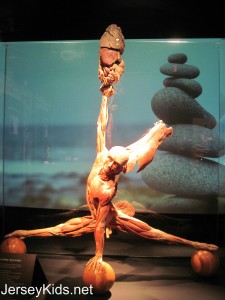
The body displays are very creative, with some flaps open (like above) to show you the inside of the body as well. Sometimes the bodies are literally sliced into pieces. It’s beautiful and artistic, yet very very disturbing.
WHAT IS PLASTINATION:
If you imagine a more extreme version of embalming, that is plastination. They pump formalin into the arteries to stop decay and kill bacteria. They dissect the skin and fatty tissue out. They remove the body fat and water by placing the body in an acetone bath, then switching out the acetone for a reactive polymer (silicone rubber) and put the body in a vacuum chamber. This removes the acetone and allows the polymer to penetrate all body cells. After this, they position the body in the desired position, using wires, needles, clamps and foam blocks. Then the body is hardened with gas, light or heat. The process takes 1,500 hours per body – about a year.
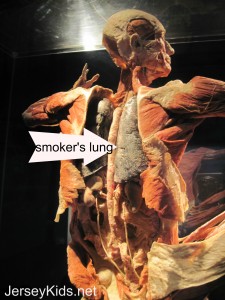
IS BODY WORLDS OKAY FOR KIDS?
I think it really depends on your kids and how you feel when looking at these pictures. My 12 year old found it all very interesting and it sparked a lot of discussion. As mentioned earlier, she still remembers seeing the black lungs (see above) from the Bodies: The Exhibition show at least 5 years ago. She most liked the photo displays on what groceries people buy in other countries, and this is a version of what I had seen online, from the Peter Menzel and Faith D’Aluisio book Hungry Planet: What the World Eats. See a photo essay here.
Americans spend 90% of food money on processed food, which is disturbing. They had one body display showing obesity, with an obese man sliced up, so you could see the amount of fat. That’s something that is memorable, like the black lung, and is a concrete way to talk with kids about health and food.
Most of the bodies in the exhibit are male, something both my daughter and I noted independently. At the end was a pregnant woman (below) and you can still see the fetus inside her. I had to look really closely in person, but what you’re seeing are the feet poking out, if you can even see it at all from this picture.
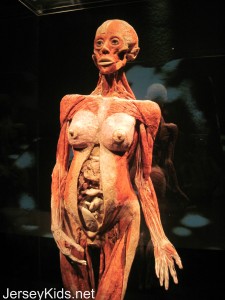
Earlier in the exhibit, they talked about bone formation, and how ossification (bone formation) finishes about age 18. After that age, cartilage is only found on joint surfaces, whereas during development, cartilage is much more present instead of bones, with bones taking the place of the cartilage.
The exhibition showed fetuses in various stages, from an embryo (too small for me to accurately photograph) on up. By 8 weeks (below) you’ll have organ differentiation largely complete in the fetus. Even at 4 weeks, the embryo has eyes.
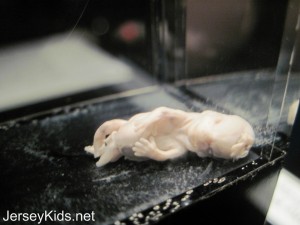
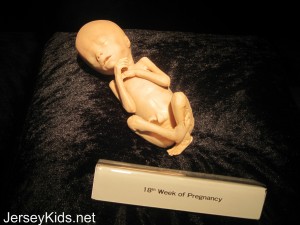
The end has an inspiring Ted video from one of the Miracle on the Hudson survivors, Ric Elias. You can watch it here, talking about what’s important in life and how he realized this from his near-death experience.
By the way, photography is not allowed in the exhibit. I had a press pass in order to take photos.
IF YOU GO:
Exhibit dates: now through April 27, 2014
Also at Discovery Times square: Shipwreck: Pirates and Treasure and LEGO: The Art of the Brick.
Where: Discovery Times Square (226 West 44th Street)
When: Open Sunday through Thursday (10 a.m. to 8 p.m.), Friday and Saturday (10 a.m. to 9 p.m.). Last allowed entry is 60 minutes prior to closing.
Tickets: $27/adult, $23.50/senior, $19.50/kids (ages 4-12). Combined ticket with Shipwreck is $37/adult, $33.50/senior, $29.50/kids (ages 4-12). Buy by phone at (866) 987-9692, or at the box office. Buy online here.
Body Worlds: Pulse Tickets/Specials: Groupon had discounted tickets, so check back when you want to go and see if they’re available. They weren’t as of this posting. If you’re new to Groupon, get the tickets here. If you’re already a Groupon user, get the tickets here.
Time Out New York has discounted body Worlds tickets which must be purchased before July 11, 2013. Tickets here are $19/adults, $18.50/seniors, $16.50/kids.
If you’re an American Express Card holder, use it to purchase tickets and you’ll get a free audio tour. Limit one per order, per Card account. They also have tickets set aside for Gold Card, Platinum Card and Centurion members for peak times, Friday – Sunday.
Logistics: You’ll need to check your bags there – they have a free coat check. They have a cupcake stand at the exit (you can go there first if you need) – get a treat after the show. No food/drinks allowed inside. We spent about an hour at the exhibition. You are not allowed to take photos.
Body Worlds provided me with tickets to review the show. All opinions are my own.

I took my kids to a different Bodies exhibit a few yrs. ago, and they retained the exact same thing your kids did : the image of the smokers’ black lungs. Some of my kids were uncomfortable with the exhibit, and I don’t know that I’d take them again (unless they expressed an interest), but just for that — for the fact that they saw, first hand, what smoking does to the lungs, and how that damage is so obvious — I think it was a worthwhile experience.
My oldest girl (11) wanted to go
My husband and me didnt want to go (see dead bodies)
It seemed very interesting
So we got her aunt (my sister) to take her
(Because she is a er nurse)
So they went and had a blast
She (my oldest) said it was amazing
We went with her again after and we thought is was very cool
We now try to go to one (if they have one) when we travel
And as mentioned she saw the smoking exhibit
It’s really worth it
We took her 9 years ago she has also never. Smoked a cigar
And is in med school
She says she still remembers her experience(s) at them